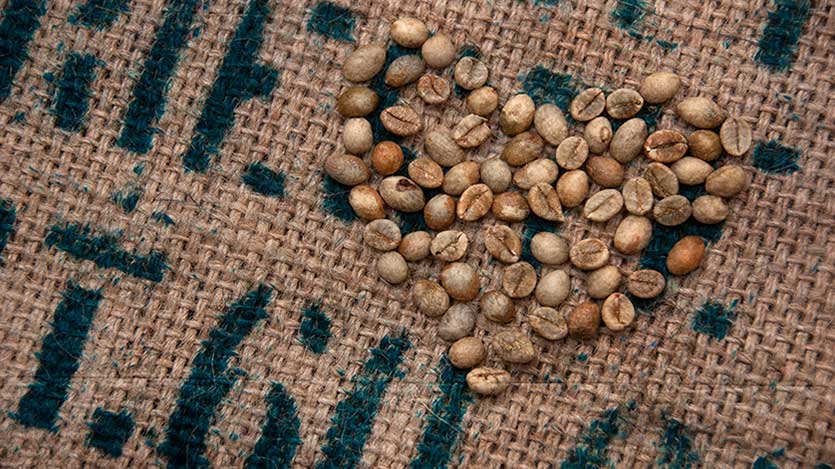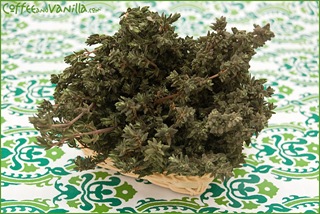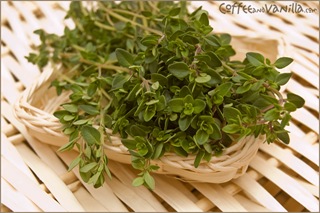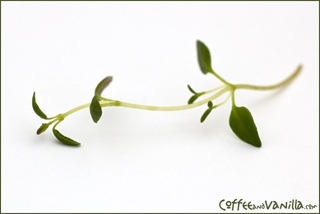There is over 350 different varieties of thyme.
Most of them have very similar flavour to described below English Thyme but there is few types of thyme that does not remind it at all, for instance lemon thyme, caraway thyme or orange thyme.
Thyme is used most widely in cooking. Thyme is a basic ingredient in Spanish, French, Italian, and Turkish, Persian cuisines, and in those derived from them. It is also widely used in Lebanese and Caribbean cuisines.
English Thyme / Garden Thyme / German Thyme (see image above)
English thyme is the most popular and if recipe calls for thyme, it is most probably English thyme, also called Garden thyme and German thyme. It is native to the western Mediterranean area, and now widely cultivated throughout temperate climes. Naturalized patches have been seen in western Massachusetts. Also, it can be found growing wild in the Catskill Mountains of New York where it is believed to have been introduced in the fleece of sheep imported from Greece. For the Greeks, thyme represented style and elegance. Its name may come from the Greek word for courage or the word meaning to fumigate. It was once burned in homes to get rid of stinging insects.
Thyme, like parsley, goes with everything-veal, lamb, beef, poultry, fish, stuffing, stews, soups, sauces, stock, herb butters, flavoured vinegars, beans, lentils, potatoes, tomatoes, cheese, onions, cucumbers, carrots, eggplant, leeks, mushrooms, eggs, and rice. You can find also thyme-flavoured honey!
English thyme is a small, evergreen, many-branched, aromatic shrub with gray-green leaves and white to pale purple flowers that bloom in summer.
French Thyme / Summer Thyme
Taste almost like English thyme but it has stronger, sweeter flavour.
Thyme is one of the Fines Herbes mix in French cuisine. This is a combination of minced chervil, parsley, thyme, and tarragon. The blend is appreciated for its freshness and its satisfying taste. It is added to food at the very last minute of cooking. Thyme is also one of the herbs in the classic blend called Bouquet Garni. This blend is tied in a cheesecloth bag or tucked between two stalks of celery and tied together to give flavour to the dish without the flecks. A Bouquet Garni includes thyme, parsley, bay, peppercorns, whole allspice, cloves, and marjoram. Tie it to the handle of the pot for easy removal. Thyme is also ingredient of Herbes de Provence. The mixture typically contains rosemary, marjoram, basil, bay leaf, thyme, and sometimes lavender flowers and other herbs. The proportions vary by manufacturer. Thyme usually dominates the taste produced by the herb mixture.
Caraway Thyme
It has a strong caraway scent.
Caraway thyme became the choice seasoning for beef. It was used medicinally to treat epilepsy, melancholy, the plague, and as an antiseptic on the battlefield in World War I. Thyme tea was believed to give shy persons courage and to alleviate nervous disorders and even nightmares.
Lemon Thyme
Lemon Thyme looks like other thymes and grows like them but that is where the similarity stops.
Lemon Thyme definitely smells like lemon and tastes like lemon. It can be used in any recipe calling for lemon juice, lemon zest or lemon flavouring. Colour of lemon thyme leaves can vary from all green, to green with purple bottom side to green leaves with lighter greenish-yellowish edge.
Lemon Thyme added to marinade is great with fish or chicken.
Jamaican Thyme
A variety of the herb thyme that is grown in tropical areas of Africa and Brazil and is very aromatic. In India it is added to beer as an extra flavouring and in Jamaica it is used in fish recipes. Jamaican thyme is also known as Indian Borage. Jamaican thyme is very similar to plain English Thyme but it’s flavour is much stronger.
Orange Thyme
An unusually low-growing, ground cover thyme that has flavour of Garden thyme with a hint of orange peel scent.
Information source: Mountain Valley Growers, Recipe Tips, Super Herbs and Wikipedia.




Hi Margot, you have an absolutely beautiful blog. And I LOVE the wholesome lunchboxes.. I would love to participate one month..
Have a happy weekend!
Hi Margot
Hope life is good. I love lemon thyme, probably my fave herb, and I use it bashed up with loads of garlic and olive oil for a roast chicken, delish!
Thanks
David
I love lemon thyme! In summer, when we grill fish, I stuff them with lemon thyme and the flavor is wonderful! I always have some in my garden.
Lemon thyme is a wonderful herb. As with all fresh herbs, if you bruise it slightly–with a rolling pin, the side of a glass or even slightly crushing it in your hands–you’ll release more of its oils and flavor.
I love thyme, I use a lot of English and Jamaican Thyme in my kitchen but I have never tasted before Lemon Thyme… I discovered it totally by chance… I buy most of the groceries online
and in my last shopping they replaced mint with lemon thyme :D
Now it will be regulary on my shopping list, I may also try to plant it on my window ;)
Terry, thank you for the tip to crush it to release flavour!
I was rubbing it in my hands, when I was removing stems ;)
Hi Margot, Lemon thyme I grew last year and it really is a lovely herb to use. I used mine bashed slightly in fish and chicken dishes – stunning :D
Rosie x
ooh, I’ve never seen Jamaican or orange thyme. I can just imagine the fragrance of the orange thyme. It would be lovely on spring vegetables like asparagus and artichokes.
I didn’t realize there were so many different varieties of thyme. I, too, love lemon thyme… and would love to try orange thyme!
Ilike Thyme or what is called Zaatar in Arabic to mixed it with boiled tea.its very healthy,and it makes my blood warm.i usually have it before i sleep.
I love cooking with thyme. It goes with so many things. I a small patch of lime thyme growing in my garden. I’d never heard of it before I found it at my farmers market. It also has a lovely, citrusy fragrance.
There are 2 herbs we Jamaicans call thyme due to scent and taste:
1) The Indian Borage (Cuban oregano, Spanish Thyme – Plectranthus amboinicus) which has fleshy stems and large broad leaves
2) The woody Rosemary-like shrub who’s tiny leaves look like English thyme